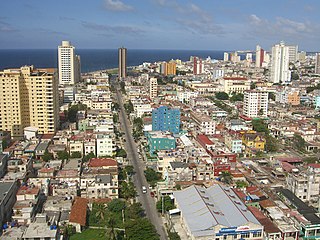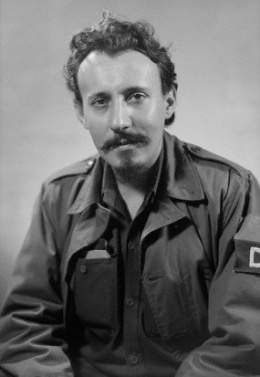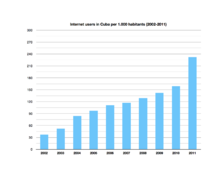
Havana is the capital and largest city of Cuba. The heart of the La Habana Province, Havana is the country's main port and commercial center. It is the most populous city, the largest by area, and the second largest metropolitan area in the Caribbean region. The population in 2002 was 2,137,847 inhabitants, and its area is 728.26 km2 (281.18 sq mi) for the capital city side and 8,475.57 km2 for the metropolitan zone.
Telecommunications in Cuba consists mainly of NTSC analog television, analog radio, telephony, AMPS, D-AMPS, and GSM mobile telephony, and the Internet. Telephone service is provided through ETECSA, mobile telephone service is provided through the Cellular Telephone Company of Cuba (CUBACEL) and, previously, Caribbean Cellular. Cuba's main international telecommunications links are through Intersputnik, with limited effectiveness of undersea telephone cables to the Americas, Spain, and possibly Italy due to underdevelopment.

Radio Havana Cuba is the official government-run international broadcasting station of Cuba. It can be heard in many parts of the world, including the United States, on shortwave frequencies. Radio Havana Cuba, along with Radio Rebelde, Cubavision Television, and other Cuban radio and television, broadcasts to North, Central and South America via free-to-air programming from the Hispasat 30W-6 satellite over the Atlantic Ocean and worldwide via Internet streaming.

Eduardo René Chibás Ribas was a Cuban politician who used radio to broadcast his political views to the public. He primarily denounced corruption and gangsterism rampant during the governments of Ramón Grau and Carlos Prío which preceded the Batista era. He believed corruption was the most important problem Cuba faced.

Hotel Tryp Habana Libre is one of the larger hotels in Cuba, situated in Vedado, Havana. The hotel has 572 rooms in a 25-floor tower at Calle 23 and Calle L. Opened in 1958 as the Habana Hilton, the hotel famously served as the residence of Fidel Castro and other revolutionaries throughout 1959, after their capture of Havana.
Cuba was the first Latin American country to begin television testing in December 1946 when station CM-21P conducted an experimental multi-point live broadcast. The first regular commercial broadcasting began in October 1950 by the small radio station Union Radio, soon followed by other stations. The broadcasts featured sport, soap operas, news, cooking shows, and comedy. Censorship was imposed following the 1952 coup by Fulgencio Batista, and again by the government of the Cuban revolution after their victory in 1959.
Radio Rebelde is a Cuban Spanish-language radio station. It broadcasts 24 hours a day with a varied program of national and international music hits of the moment, news reports and live sport events. The station was set up in 1958 by Che Guevara in the Sierra Maestra region of eastern Cuba, and was designed to broadcast the aims of the 26th of July Movement led by Fidel Castro.
Censorship in Cuba is the topic of accusations put forward by several foreign groups-organizations and political leaders, as well as Cuban dissidents. The accusations led the European Union to impose sanctions from 2003 to 2008 as well as statements of protest from groups, governments, and noted individuals.
Fabio Grobart was a Marxist-Leninist revolutionary and politician who played an important role in the 1959 Cuban Revolution that overthrew Fulgencio Batista and led to Fidel Castro's rise to power.

Eusebio Leal Spengler was a Cuban historian. He served as the municipal historian of Havana, as well as the director of the restoration project of Old Havana. Under his oversight, the historic centre of the capital city became a UNESCO World Heritage Site. He also authored books and hosted radio and television programs that recounted the city and its history.

Henry Pollack is the Cuban born American host and founder of "Havana Rock," a radio program that has been on the air since May 1995, the Miami, Florida show on radio station WWFE 670 AM and has enjoyed a cult following since it first aired in 1995. The show has received much praise for its staunch anti-Communist stance and has been featured on CNN, BBC, ABC and Fox News. It is also the only radio show in South Florida that is completely bilingual. He is also the editor of an anti-Fidel Castro web sites on the net, which went online in 1998 as one of the first anti-Castro websites on the internet.
Luis Enrique Aguilar Leon, J.D., Ph.D. was a Cuban journalist, professor and historian. He was a professor to Bill Clinton and a classmate of Fidel Castro.

The Cuban Institute of Radio and Television was the government agency responsible for the control of radio and television broadcasters in Cuba. On August 24, 2021, the institute ceased to operate and was replaced by the Institute of Information and Social Communication.
The Cuban government directly prevents access to certain websites. While preventing access to certain websites is present, it is not particularly extensive. Limited access to the Internet through limited internet infrastructure is the main problem with Internet access in Cuba.

The University of Havana is a public university located in the Vedado district of Havana, the capital of Cuba. Founded on 5 January 1728, the university is the oldest in Cuba, and one of the first to be founded in the Americas. Originally a religious institution, today the university has 15 faculties (colleges) at its Havana campus and distance learning centers throughout Cuba.

CMQ was a Cuban radio and television station located in Havana, Cuba, reaching an audience in the 1940s and 1950s, attracting viewers and listeners with a program that ranged from music to news dissemination. It later expanded into radio and television networks. As a radio network it was a heated competitor of the RHC-Cadena Azul network.
The Cuban Revolution was not only fought by armed rebels on the battlefield but also through the propaganda campaigns designed and orchestrated by Fidel Castro and his rebel comrades. Propaganda in Cuba during the revolution included Castro's use of personal interviews with journalists, radio broadcasts and publicity seeking operations that contributed significantly to the victory of the rebels over Fulgencio Batista's government and provided insight into the successful propaganda campaign established by Castro after gaining power. The limited yet successful revolutionary propaganda apparatus transitioned into what Castro has called "one of the most potent weapons in his foreign policy arsenal." Today the Cuban government maintains an intricate propaganda machine that includes a global news agency, magazines, newspapers, broadcasting facilities, publishing hoes , front groups, and other miscellaneous organizations that all stem from the modest beginnings of Castro's revolutionary propaganda machine.
Press freedom is an ongoing issue in Cuba. The country has ranked low on the Press Freedom Index, a list published by Reporters Without Borders which reflects the degree of freedom that journalists, news organisations, and netizens have in a country. Cuba has been ranked among the index's “least free" countries for a decade. In 2016, Amnesty International reported that the re-establishment of diplomatic relations between the United States and Cuba in December 2014 "renewed hope for an end to the US economic embargo, which has had a direct impact on the human rights of ordinary Cubans."

The Radiocentro CMQ Building complex is a former radio and television production facility and office building at the intersection of Calle L and La Rampa in El Vedado, Cuba. It was modeled after Raymond Hood's 1933 Rockefeller Center in New York City. With 1,650 seats, the theater first opened on December 23, 1947, under the name Teatro Warner Radiocentro, it was owned by brothers Goar and Abel Mestre. Today the building serves as the headquarters of the Cuban Institute of Radio and Television (ICRT).

Faure Chomón Mediavilla was a Cuban historian and politician. He was one of the founding members and leaders of the Directorio Revolucionario 13 de Marzo. After the triumph of the Revolution he joined Fidel Castro's government. Early in his career, he served as the Secretary of Communication and Transportation and Ambassador to the Soviet Union. Later he served as Ambassador to Vietnam and Ecuador as well as historian of the Revolution. He was also member of the National Assembly of People's Power from 1976 to his death.












